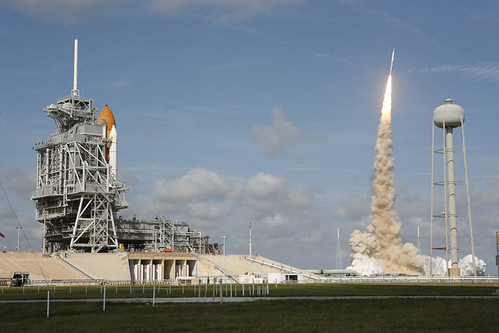Welcome back to What's Up?
During the last few months, NASA's plan to get people back to the Moon has been under fire. It is said to be far behind and over budget. There are even rumours that the Obama administration is going to cancel the project altogether. Humankind returning to the Moon is well overdue, the last visit to the Moon was 38 years ago!
There is a growing number of people among the general public that believe NASA never sent astronauts to the Moon. This isn't some small fringe group anymore, there is actually a significant percentage of people who believe that the Moon landings were a big conspiracy.
A study in Russia found that 28% of Russians doubted that Americans had landed on the Moon and another study found 25% of Britons doubted the Moon landings. Even in the United States, about 25% of Americans between the ages of 18 and 25 are not sure the Moon landings actually happened.
There are also quite a few documentaries regarding the possibility of faked Moon landings, but do they actually have any good arguments?
One of the most common arguments against the Moon landings is how the American flag appears to be waving in the wind in photographs. Since there is no air on the Moon, how could the flag stay up and ripple in the wind?
If you carefully examine the pictures of the flag, you'll notice that a rod goes along the top of the flag to hold it up. The reason that the flag looks like it's waving isn't quite so obvious. When the astronauts were opening the flag up the rod didn't extend all of the way and the flag retained its rippled appearance from being folded up in storage. Although the flag shook for a few seconds it stood still afterwards it may still be standing there to this day.
The rippling flag that wasn't actually rippling in the wind! What else do the Moon hoaxers have for evidence against the Moon landings?
In the pictures it has been noted that there are no stars visible in the photographs. Can this be explained?
If you've ever tried to take a picture of something well-lit with a dark background you'll notice that you can't see the background at all. This happens because the camera adjusts its shutter speed so it won't take in too much light and make the well-lit object in the foreground too bright. Since the camera doesn't take in as much light, anything in the background that is too dim will not appear in the image.
Speaking of pictures, why are there no pictures of the lander, rovers, and instruments left on the Moon?
Well, actually, there are! Just last year NASA sent up a probe that is orbiting the Moon taking pictures of the Moon's surface in high detail. In some of these images the lunar lander module can clearly be seen and even trails of footprints can be seen!
The landing gear from the Moon landings was never been imaged before that because the Moon is on average, about 385,000 km (240,000 miles) away. Earth based telescopes can't see details on the Moon much smaller than a kilometer because of Earth's turbulent atmosphere, while the space-based Hubble telescope can't look at the Moon because it's too bright.
The final nail in the coffin for the case against the Moon hoax is the fact that special reflective mirrors were placed on the Moon by the astronauts. When a powerful laser is pointed at these mirrors, the light bounces back and can be detected with a large telescope. When the laser is pointed somewhere else on the Moon, no detectable light reflects back.
While our thoughts are still on the Moon, let's see what's up this month.
There will be a new Moon on Feb. 13 and will swell to a full Moon by Feb. 28.
Mars will be visible high in the south-east while Saturn will be rising in the east after sunset. Jupiter and Venus may be visible setting in the west shortly after the sun.
The Athena Community Astronomy Club's monthly meeting will be on Feb. 28, the last Sunday of the month.
Until next month, just look up!
Hey Kids...
Remember those Mars rovers Spirit and Opportunity? They were originally planned to drive for 90 days but have been going for over six years! Spirit has been having a lot of trouble lately. It recently got stuck in some deep sand and isn't able to get out. It can watch the weather and scientists can still learn some things from the stationary rover. The big issue is winter on Mars. The sun is getting low in the sky and it's going to get very cold. Spirit will spend the winter hibernating and will hopefully wake up in the spring. Keep your fingers crossed for Spirit!



